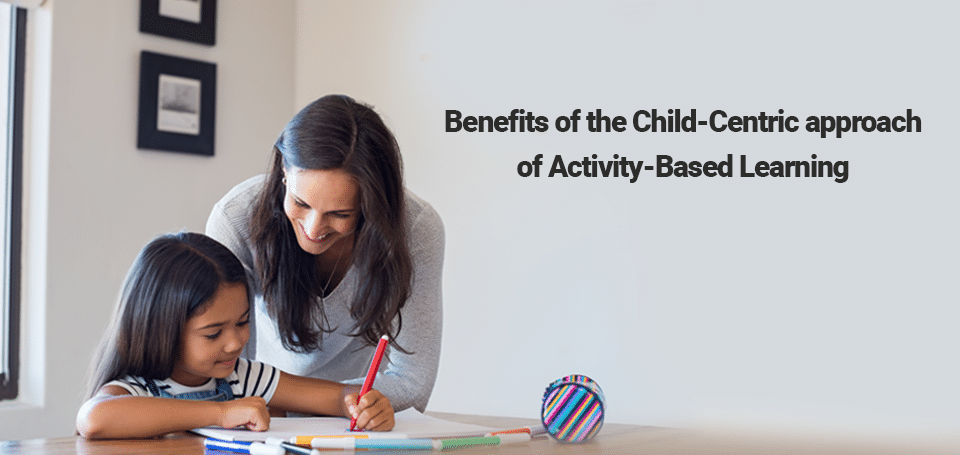David Horsburgh, the British educationist, pioneered Activity-based learning, also called ABL. ABL is a way of learning whereby children learn at their own pace, through different supervised activities. It is an interactive and engaging way of teaching children. ABL helps monitor certain skills in children, such as speech, coordination, motor skills, and social skills among many others.
ABL is an innovative and enjoyable approach to learning, as it boosts the development of the brain in children, by providing constant stimulus and prompting them for responses. Activity-based learning is achieved through three main ways – exploration, experimentation, and expression.
Activity-based learning is of two broad types. The child-centric approach, wherein the teaching is designed with the student as the major factor and by keeping the student in mind. The second type of ABL is the teacher-centric approach, wherein the teacher is in the lead role, leading the student through the entire process. In this article, we will talk about the benefits of the child-centric approach of activity-based learning. Here are some of the benefits…
1)Children become more inquisitive and independent: The child-centric approach of ABL encourages children to think analytically. It sparks their curiosity, which in turn, makes them active and not passive learners. Children also become more observant. The child-centric approach of ABL focuses on learning by doing. By asking children to work on their own or in small groups, ABL encourages students to be independently inquisitive, think critically, and learn from their own experiences. This is a self-directed learning process that results in the acquisition of knowledge outside as well as inside the educational environment.
2)Supports the development of social skills: ABL’s child-centric approach improves the confidence of children. It also tests their cooperation levels when they work and study in groups. Moreover, it builds their communication skills. The children continuously challenge themselves and come up with creative and innovative solutions. ABL helps children develop teamwork and social skills. These skills will later prove essential to their work and to their social lives.
3)Enhances memory: The child-centric approach of ABL results in doing rather than simply reading or listening. This enhances memory with the retention and recall rates being much higher. The process of gathering knowledge through personal experience and experimentation helps children memorize and understand learning material.
4)Children can express themselves freely: The child-centric approach of ABL helps children get in touch with their emotions and also convey them successfully. ABL also encourages children to be creative in the way that they express their knowledge. This child-centric approach of ABL provides students with the opportunity to express what they have learned through the act of doing, as well as through the act of verbal presentation.
5)Encourages continuous engagement: This is an extremely valuable benefit. Since children are actively engaged in all activities, the possibility of inattention is minimal. With children being involved every step of the way, straying away from the activity is almost impossible.
6)Allows for variability inability: Not all children grasp concepts and things at the same pace, time, or degree. Each child is unique, especially in their ability to learn. The child-centric approach of ABL promotes learning at the pace of each child. This eliminates the stress that comes with traditional learning, with the child learning at her pace and time during ABL.
7)Results in motivation: Each child feels a very real sense of accomplishment in performing each activity. They feel motivated by all of their achievements. This enhances their confidence and helps them believe in their abilities.
8)Emphasises the relevance of educational material: When learning by the traditional route, children do not always understand the relevance of the learning material. ABL, on the other hand, helps children understand the real-life relevance of learning material by encouraging them to explore and solve realistic scenarios and problems.
The child-centric approach of ABL is the perfect teaching approach, especially for children. This teaching and learning methodology has gained such importance that even toy companies are using this approach to design activity-based and educational toys. These help in keeping children constantly engaged during their ABL activities.
While ABL is enjoyable it is no less rigorous than traditional learning. ABL uses activities in each milestone that includes games, drawing, rhymes, and songs to teach letters, words, math, science, or concepts. Integrated into the curriculum are activities that enhance awareness about the environment, health, nutrition, and sanitation. This awareness is brought about through innovative methods, such as a puppet show or songs and rhymes.
At the Epistemo Vikas Leadership School, we encourage both ABL and Differential Learning. We weave in activities into the regular curriculum and also take our students beyond Academics into Futuristic Education, as well as into cutting-edge topics such as Robotics. Our Differential Learning program ensures that all students are engaged in the learning process by providing tasks that match each individual’s needs.
Our ABL curriculum excites the brilliant student to uncover deeper layers of learning, while simultaneously structuring the curriculum to support lower-level students, as well as those with identified and unidentified learning disabilities.
For more information about Activity-Based Learning (ABL) and any other queries, contact the Epistemo Vikas Leadership School at +91 7702800800 or at info@epistemo.in or visit our website at https://epistemo.in/

